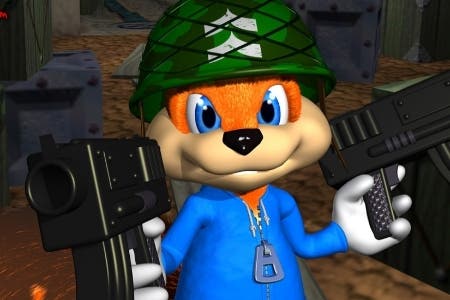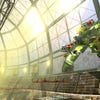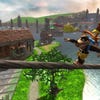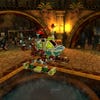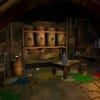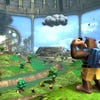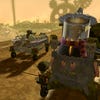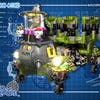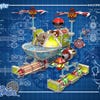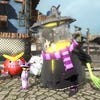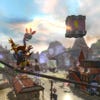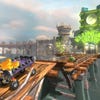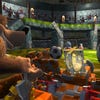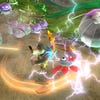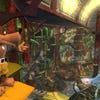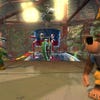The man who made Conker - Rare's most adult game
From the archive: Chris Seavor on cancelled projects, the good old days and losing his rag.
Every Sunday we present an article from our archive - giving you a chance to discover something for the first time, or maybe just to get reacquainted. This week, with the Conker-starring Project Spark finally releasing, we go back to Wes' interview with the man behind Rare's foul-mouthed mascot.
Chris Seavor left Rare in January 2011 after 17 years at the legendary UK developer. While there he worked on most of the studio's games: Killer Instinct, Perfect Dark and Banjo-Kazooie included. But he's best known for taking the cute Twelve Tales: Conker 64 and turning it into the profanity and poo packed N64 adventure Conker's Bad Fur Day - Rare's last game for a system that had never seen anything like it.
After the studio he so loved was bought by Microsoft he remade Conker's Bad Fur day for the Xbox. Conker: Live & Reloaded launched in 2005 with dumbed down content and Live-enabled multiplayer. We haven't seen a game in the series since.
After that, Seavor headed up multiple Xbox 360 projects that never saw the light of day, some much discussed, some never discussed. Conker 2, Perfect Dark Core, Ordinary Joe and Urchin, among others. He saw Kameo 2, a motion control game called Savannah and more fall by the wayside.
Now, he is master of his own universe once again. After taking a year off he founded indie developer Gory Detail and in eight months built Parashoot Stan, a top down endless runner for iOS devices out next month. His next game is already in the works.
Here, in a wide-ranging interview with Eurogamer, Seavor recounts the glory days at Rare and discusses the many games he and others worked on that never saw the light of day.

Why did you leave Rare?
Chris Seavor: I left Rare under duress as it were. They made me an offer I couldn't refuse and that was that really. It was probably a good time to go because there were quite a lot of changes going on that certainly didn't sit that well with me.
Like what?
Chris Seavor: They sacked a load of artists, and I was among them. Well, redundancies I guess you could call it. It was quite a lot in one go, for whatever reason, which I'm still not even clear about. This was January 2011. I took a year off and just dossed around really. I did a bit of travelling.
Did they make it worth your while?
Chris Seavor: It was all right, yeah. I'd been there a while. I came to Rare in the beginning of 1994 straight from college, and I was straight in at the deep end onto Killer Instinct, which was not called that at the time. It was in the first month of getting the gig. Donkey Kong was halfway done, and then Williams wanted this fighting game, so Rare said, yeah, okay, we'll do that.
What was it called before it was called Killer Instinct?
Chris Seavor: Brute Force was the original codename. It was Martin Hollis who came up with the name one day, and everyone went, oh, that's good! We'll never get that. Somebody will already have that. And then we checked it and it wasn't. It was like, okay, yeah, that will do.
That took a year. Those were the days when we used to do big games really quick. Not like now, when it takes three years at least. We knocked that out in a year. It was a trial by fire. But it was really good times. Rare was a family business - very much so at the time. Not like it is now. Tim and Chris (Stamper) and the whole family, you were included in that family. It sounds a bit creepy but it was actually quite good. You were part of their family. Tim's mum used to cook us lunch. Tim's dad always used to do stuff for us. It was good. It was like a really tight unit in the first couple of years I was there, and then it started to expand. Donkey Kong, then Killer Instinct, then it just absolutely exploded as a company. That's when it really grew and lost its intimacy.
I did bits and bobs of work for this that and the other, and then we started doing Conker Twelve Tails, and then that all fell apart. I had an idea with that, so I took that, went to Chris and said, what about this? Let's make Conker a bit more mature and do something different with it? He said, great, go for it - not expecting much I imagine. Two years later we released it and it was critically acclaimed but not strong in sales, but there you go.
Seavor took Twelve Tales: Conker 64...
It was a bit out there for a Nintendo game.
Chris Seavor: It was. It was quite a brave move I thought. I was surprised when they said yeah, okay. There are some bits in it where I look back now and I go, oh god, I don't know how we got away with that. I think Live & Reloaded was more dumbed down than the original Nintendo one, which is ironic.
I was quite happy with what it sold. But at the time other games at Rare were selling upwards of five, six million units, and you were being compared to that. So you get a game that sells a million, which by nowadays standards I'd say is pretty good, back then it was like, oh, it's only sold a million. Christ! We were up against stuff like Diddy Kong Racing, which sold immense amounts. Even Perfect Dark. So it got eclipsed a little bit. But the fan base was really strong. My name became associated with the character. Within that community it was quite a good thing.
And turned it into Conker's Bad Fur Day, starring The Great Mighty Poo
We did a few other prototypes that didn't come to much, and I did some graphics work on the side just within the company, because that's what I started doing, it wasn't design. And then Microsoft came along and said here's a load of money, we're going to do stuff now. And somehow we ended up doing Live & Reloaded. I'm still not sure how that happened. I'm still not sure that we shouldn't have done Conker 2. In fact I'm certain we should have done.
Why do you feel that way?
Chris Seavor: I started designing it and we were going to do it. They just wanted it quickly. It was coming to the end of the life cycle of the Xbox, and there was talk of them going, look, can we just shift this over to the 360, which was a year away? I was really against that because I just couldn't face spending another two years on a game we'd already spent a year and a half on. So I guess it was probably my fault.
Now, I would have gone, absolutely. Let's take a step back and make the graphics look as good as we can. It would have done all right I think. From the amount of messages I get every day saying please make Conker 2 I'd say it would have been a better move, but hey. There you go.
What kind of game would it have been?
Chris Seavor: It would have been a straight sequel. It would have been the day after or the week after. I designed quite a lot of it. The story is all done. That was all nailed.
Do you care what Microsoft has done with Rare?
Chris Seavor: I don't really care about what Microsoft are doing with the company. What I care about is whether or not my old friends who still work there are happy or not. They're the ones I have to sit and listen to in the curry house.
Are they?
Chris Seavor: Some are. Some aren't. It depends. They're content.
That's very diplomatic of you.
Chris Seavor: It is. You see, back in the day, you had a lot more to do because there were a lot fewer people. It was a different atmosphere. Overtime, you just did it. And there was no question about it, because you had to because you had so much work. Whereas now, because it's quite a corporate place, it's all about filling out forms, which completely flies against certainly what I think needs to be done to make a game.
If you've got a team of 150 people fair enough, you do need some management. But if you've got middle management and managers and program managers who are managing two people and there's three program managers, which hypothetically I imagine goes on at places, I don't think that works very well. My last memories of the place are it was heading in that direction. It was getting top heavy.
Rare had already done Kinect Sports and the all the other Kinect stuff before you left.
Chris Seavor: They had, which was a massive hit. It sold hugely. So you can't really argue with the strategy in terms of making money. But is that what the fans wanted? I can pretty much guarantee no, it wasn't. Not at all. You get people complaining Rare has had it, but they produced a game that sold four or five million units. You go, oh, okay, well they must be doing something right. I really don't know where I sit with that one.
Killer Instinct, they've still got that. There's definitely a market for that game.
XBLA for the original game, just tart it up a bit, stick some nice 3D graphics, keep the gameplay exactly the same. That would sell. I'm absolutely certain of it
Chris Seavor
A third one?
Chris Seavor: I'd say so, yeah. XBLA for the original game, just tart it up a bit, stick some nice 3D graphics, keep the gameplay exactly the same. That would sell. I'm absolutely certain of it. But it's whether they'll just do it or not. I know what I'd do if I was in charge of the place, but I'm not. So we'll have to see where it's going.
I haven't got a clue. No-one tells me anything about Rare now. I think they dare not in case I tweet it. I presume it's another Sports game.
What were you doing before you left?
Chris Seavor: They set up an off-shoot studio in Fazeley. It was where the graphics went. Quite a few people didn't want to make the move because it's the centre of Birmingham as opposed to Twycross, which is a bit of a wrench. But I thought, I'm all right, I'll go for that. So I did that for nearly a year. And I went back to doing graphics again. They were only doing one game and they had twenty designers on that. I went, I'm sorry but that's not how I work. I'm not doing that any more. I'm not designing. I like to be in charge. And if you've got a committee of people all fighting over how fast a tennis ball should bounce, you know you're not really going to have much of an input. So I went back to doing graphics.
I really enjoyed that year. It was just doing graphics for the promotional stuff. A little bit of work for the London studio to do with Live. Just bits and bobs really. Nothing in any way challenging. But it was all right. I didn't mind. All my mates were there, so we had quite a good time in Birmingham. And then that was it. They dropped the bombshell of, we're getting rid of all the artists except for whatever was that was left - ten per cent of them. I just went, oh, okay. That was it. Within a month of me finding that out I knew I was out. I just went, fair enough. I'm going to go chill out and I might make something else at one point some day.

What about these games I've heard you were making, Ordinary Joe, Urchin...
Chris Seavor: They were quite a way before. That was the last year, so the year before that I still had a little team. We did Perfect Dark Core, which was going okay. It was all right. There was a load of tech. I was trying to do something quite different with that. I wanted to get away from the go around the corner, shoot, on rails kind of game, which a lot of games are doing now. If you look back at what games were like, like GoldenEye and Perfect Dark, all the old games like Deus Ex, you compare how complex they were in terms of the multiple paths, first-person shooters now have gone backwards in time in terms of design, but way ahead in terms of graphics. It's a bit of a shame. But I was trying to get it back to that more open-ended sandbox feel to first-person shooters.
It wasn't as narrow as something like Call Duty, where it's like, walk, cutscene, walk, cutscene. It was definitely going to be, you could go over here and do this over here, or you could go over here and do this over here. And then it would bottleneck down to something that would then take you to the next bit. It was very much about missions and storyline.
So it was like Deus Ex then?
Chris Seavor: Yeah, definitely. That's one of my favourite games. I really like that game. I thought, if you could get something like that but make it look amazing, you're probably on a fairly good direction to having a hit.
It was quite dark. I didn't like what was done with her character in Perfect Dark on Xbox 360. Personally, I didn't think the character was very strong, who she was. She is meant to be this assassin and it's like, oh, she looked a bit like a pantomime. She looked very corny.
You didn't work on that game then?
Chris Seavor: No. I was too busy doing other stuff.
But you headed up the development of Core?
Chris Seavor: Yeah. I wanted a change and I asked them. They said, okay, we'll get back to you. That's when I started Urchin, which was a dark fairytale from the point of view of a character who was the baddie rather than a good character. It was in the mould of Fable. The hook was, it wasn't about whether you were good or bad. It was about how bad you were. But it was moral in that badness is down to your point of view, which is how I managed to get it to work in terms of problems parents might have with it.
When you killed the princess and ripped open her guts to get her heart, which was one of the quests, on the face of it it looked like you were quite a bad character, but in reality you'd then find out the princess was an evil vampire character who was killing local girls. That was an example quest. That's how we managed to pitch it so it was all right with all the ratings people. That would have been quite good. It was certainly different.
When were you making Urchin?
Chris Seavor: Straight after Live & Reloaded, for the Xbox 360. We did a load of stuff. We had the graphics looking great on that. We spent a good eight months on that. We had a fighting system I called “Dirty Fighting”. The girl was quite brutal. So when she fights she has to use everything. She's not very strong so she has to be very clever. So she does things like kick them in the knackers and use traps. She had a pall, this pig, who you also used in quests. He was quite heavy and strong, and she was quite light. It was a kind of a Banjo-Kazooie dynamic in that one was helping the other and one had strengths and one had weaknesses. But it was also about the character.
We did the thing Molyneux said he was going to do with the dog in Fable. We had already done it with the pig in that it was also the thing that was your manual, the in-game help. He would tell you stuff and say, oh, that's interesting, what's over there? And off he'd run. It worked really well.
We did the thing Molyneux said he was going to do with the dog in Fable. We had already done it with the pig in that it was also the thing that was your manual, the in-game help
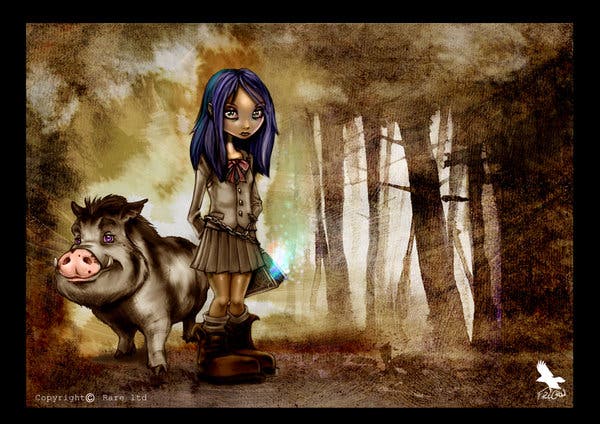
Why didn't it come out?
Chris Seavor: It was going along and going along, and Microsoft were quite interested and then they weren't. Just at that point when we were going shall we do this or not, are we going to pitch this for a greenlight, Chris and Tim said, oh, do you want to do PD? I went, oh, all right then. So we carried on with that.
That was another one of those things where I look back and think, should I have done that? Should I have stuck to my guns? I don't know. It's hard to say.
What might have been?
Chris Seavor: I know. Well, it's still there. I've still got it. I've got all the designs. It's all sat there. You never know. It won't be called Urchin, but it's still there. Who knows one day, when I make loads of money and get a much bigger team. It was the game I always wanted to make.
So then you worked on Perfect Dark Core.
Chris Seavor: Yeah. We did that for nearly a year. That was going quite well. It had some nice mechanics. We were doing all the parkour jumping from walls stuff.
I've seen some videos of it online.
Chris Seavor: Yeah. The stuff that's been leaked online was actually really old stuff. To this day I don't know where that came from. But we had that really good. There was a really nice feel to it. So you could fight like that, and then there was the more traditional gun shooting.
It was in the works for a year. Why was it canned?
Chris Seavor: I'd heard rumours PD wasn't the big hit that was expected. They really expected it to be massive and there was a bit of disappointment at the sales. That tempered doing another one.
Plus, Microsoft were reassessing the market at the time. They were looking at the whole spread of games they had across Game Studios. And they had Halo, which was a pillar game. They were thinking, well, we've got that. We've covered our bases with that. So why do we need another game that's like Halo? Really, that was it. And they just went, look, close it down.
They were looking to make Rare into what Nintendo had Rare as but for Microsoft. They were saying, okay, why aren't we doing these cuter games? That's what Rare does - which is actually not true. But that's the way it was seen. So they pushed the Banjo game and they just got everyone on it. It was just a case of, this must be done by this date no matter what. And that was it. It was all hands on Banjo and that was the thing we did. That's what happened.
I did resist going onto Banjo and I did some more mini demos of a survival horror game, which I'd had on the back burner for a while.
Was that Ordinary Joe?
Chris Seavor: Yeah. We did some tech for it. It was all right. It was okay. But I knew at that point I was never going to get a team to finish this, so it was just a matter of time. I only worked on it for three or four months, and there were three of us in a corner with a big sign saying, keep out. I really enjoyed that period because we were just being really creative. Even though no-one else could give a s**t, we were being really creative and doing some really good stuff. It's a pity no-one really seemed that bothered, certainly Microsoft, who were only interested in Banjo. That was fair enough I guess.
That was it really. That was the last time I did any design at Rare. And then it was graphics from then on and bits and bobs for other games. Nothing to speak of really.
I've read Rare wanted to make Killer Instinct 3 but Microsoft said no.
Chris Seavor: I don't know about that. I didn't ever see anyone do anything with it. If anyone had made a model of Jago, which if Rare was interested they would have pitched it, that never happened as far as I know. I'm pretty sure I would have known about it if someone had done that, having been involved with the original game. But, no, I'd say that's not true. That sounds like a rumour to me.
Ken Lobb's still at Microsoft, and he's the god of Killer Instinct. He was the guy who got it all off the ground on the Nintendo side back in the day. He was the big evangelist of it. I'm pretty certain the thing he'd want most in the world is a version of Killer Instinct. So I'd be surprised if Microsoft didn't want it. I just think people were too busy doing sports games and it was too much of a drain on the resources.
But now? How knows? Maybe that's what they're doing now. I have no idea what they're doing.
It was very nice Savannah. I'm surprised they didn't go with that game. It would have fitted so well on the Kinect
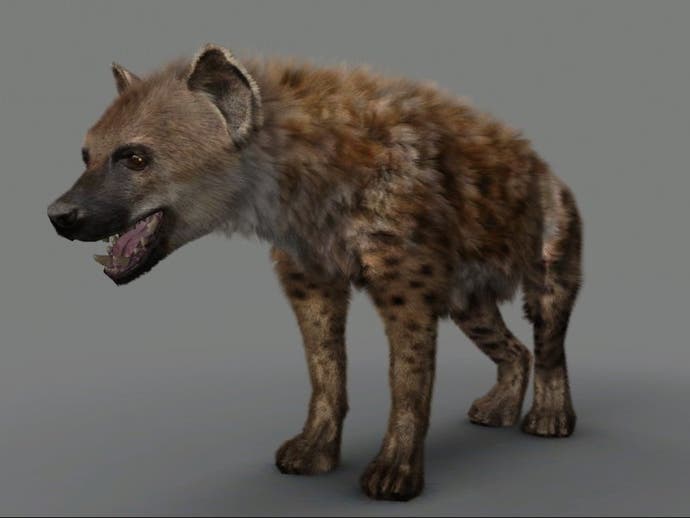
What was Savannah?
Chris Seavor: It was very nice Savannah. I'm surprised they didn't go with that game. It would have fitted so well on the Kinect. At the time Kinect was just about coming into its own. We actually had a different controller, which was in-between a normal Xbox joystick and what the Kinect is now. There was this kind of in-between controller, which was neither one thing or the other.
I think it was when Don Mattrick turned up and looked at it and went, no, we're not doing that. So that got canned and unfortunately it dragged Savannah with it. If they'd had carried Savannah through onto the Kinect it would have worked really well. It was Phil Dunne's little baby. I wasn't involved with it. It was basically a nature programme, sort of David Attenborough documentary, but you influenced events by controlling little cubs and breeding them and sending them off into the wild.
It was quite gruesome. It was quite real. But it was a nice idea. It was very gentle gameplay. For the Kinect at the time it would have been a nice genre to plant there. At the time with Kinect they were trying to pull it away from more traditional gruesome games and serious games the Xbox was getting known for. It's a shame they didn't do it really.
What was this controller?
Chris Seavor: Kinect just sort of came along. I'd heard the codename, and every time I spoke to anyone who might have known about it they just looked at me and said, if we tell you we'll have to shoot you. It crept into the scene. Dev kits didn't turn up for ages, and eventually it trickled out. We didn't have a big reveal where we wall went into the room and said, here it is, this is Kinect. One day suddenly it was like, oh, okay, I see what it is. I get you. No controller.
This other thing was a very simple controller. It was just one button and a tilt thing on it. It was a prototype. It wasn't a real thing. When we first got our prototype N64 controllers it was literally made out of Lego with cardboard, but it did the job. This was the same thing. I'm not surprised they said no. It didn't have a name. I just remember seeing it thinking, this isn't very good, is it? I guess Don Mattrick thought the same thing when he saw it.
Did you work on Kameo 2?
Chris Seavor: No, but I did see it and it was very nice. It was another one of those, why didn't they just carry on with that? It was a lot more mature than the original game. Some artwork leaked. It was more open world. Assassin's Creed had just come out and everyone was playing that. Kameo 2 was taking some cues from that and using Havoc animation stuff, these reverse kinematic animation systems to make everything look really smooth. They were getting all that working and it did look really good. It had been in the works for a while. George Andreas started on that pretty much straight after Kameo, so it was going for a good while. Another one of those, what ifs?
It seems like there were quite a few of those at Rare.
Chris Seavor: Yes, there were. We probably spread our butter too thin. We had three quite big teams that weren't quite big enough. It was getting to the point where games needed massive teams. We probably had a massive team's worth of game, but we didn't realise that was what we needed to do. That was what eventually happened with Banjo. It was just all hands on that and it was still tight to get it done, just because the graphics were a ridiculous amount of work.
How do you feel about your time at Rare now?
Chris Seavor: I had a good time at Rare. I got out at the right time, that's for sure. And I'm really enjoying what I'm doing now because I'm on my own. I don't have to have these meetings with people where you go in and you go, oh god I'm going to be a slave to someone else's lack of vision here. I had some tense meetings over the years, that's for sure. I don't have that any more. I just go, we're doing this. That's it.
I had a good time at Rare. I got out at the right time, that's for sure. And I'm really enjoying what I'm doing now because I'm on my own
Did you ever get into full-blown shouting matches with others?
Chris Seavor: Yeah, I did. I was a bit known for that if I'm honest. There have been a few doors slammed. It didn't happen too much in the old days with Tim and Chris. It was more intimate back then. You could talk to them. I wouldn't say they were friends, but they were people you felt comfortable with.
Later on it was very much a hierarchy. I don't know if that's a good thing. I guess you don't have much of a choice if you're a bigger company. It was very much us and them sometimes. And I can get quite passionate, which gets mistaken for being troublesome, which I don't think helped my cause in the end. I mellowed out towards the end anyway. I was like, yeah, whatever. If you want to do that, that's fine. Just give me something to do. Get me to five o'clock so I can go home, which would have been unheard of back in the day. I was there till 11 or 12 most nights for the first five or six years at the company, because I enjoyed it so much.
What pissed you off the most?
Chris Seavor: Testing probably. Trivial bugs. There was one bug, right, that was on Conker, and I f***ing absolutely flipped. It was some twitch in the controls, something odd going on. They were getting really s**tty about it, saying, this has to be fixed! It was taking up loads of people's time trying to find it when there was other stuff that needed to be done. We went down there and we said, right, show us this bug now. You show us this bug you get every time.
They showed it to us and it turned out his controller was faulty. We'd wasted a week on this and it was just a dodgy connection on his controller. I must admit I wasn't too happy about that and I blew up.
On the team itself? Yeah, every now and again. I do lose my rag a bit. Everyone says I've mellowed out. In the early days I could get a bit abrasive. I'm still friends with most people so it can't be that bad.
